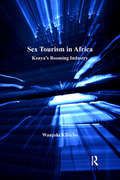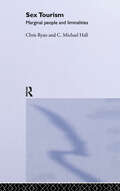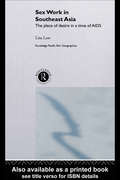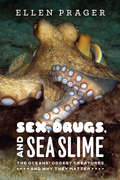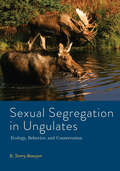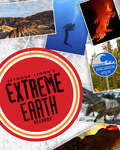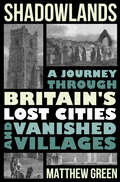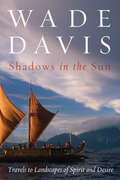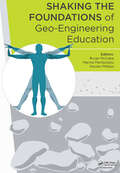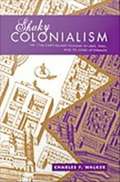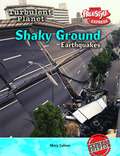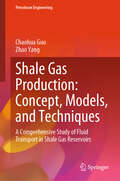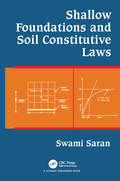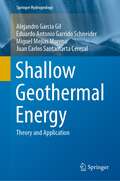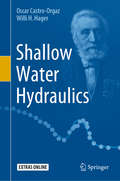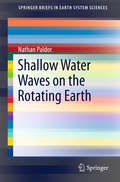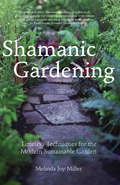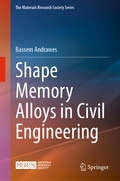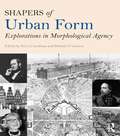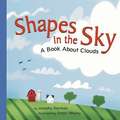- Table View
- List View
Sex Tourism in Africa: Kenya's Booming Industry (New Directions in Tourism Analysis)
by Wanjohi KibichoIllustrated by in-depth empirical research from Kenya - one of the most popular country destinations in Africa for sex tourism - this book gathers much-needed statistics and data, and then critically examines the features of tourism and the sex trade, contextualizing this in relation to tourism development. It addresses the conditions which generate this 'social problem' and, while not taking a potentially problematic moralistic stance it questions whether this trade is exploitative in nature, particularly in cases of child sex tourism. It then critically evaluates the current policies in place to regulate the sex tourism industry and provides suggestions for future direction.
Sex Tourism: Marginal People and Liminalities
by Chris Ryan Michael C. HallSex Tourism examines the issues which emerge from sex worker-client interactions and from tourists visiting 'sex destinations'. It is a comprehensive summary of past research by academics and original primary and secondary research by the authors and has examples from Asia, Australasia and the USA.The authors have generated new models to show different dimensions of sex tourism, which normalise at least some components of the sex industry, and represent a new way of looking at sex tourism by challenging the preconceived perceptions that some people have of sex tourism or confirm the impression of others. Sex Tourism looks at issues of importance to those working in tourism, women's studies, gender studies and social change.
Sex Work in Southeast Asia: The Place of Desire in a Time of AIDS (Routledge Pacific Rim Geographies)
by Lisa LawSoutheast Asian sex workers are stereotypically understood as passive victims of the political economy, and submissive to western men. The advent of HIV/AIDS only compounds this image. Sex Work in Southeast Asia is a cultural critique of HIV/AIDS prevention programmes targetting sex tourism industries in Southeast Asia.
Sex, Drugs, and Sea Slime: The Oceans' Oddest Creatures and Why They Matter
by Ellen PragerWhen viewed from a quiet beach, the ocean, with its rolling waves and vast expanse, can seem calm, even serene. But hidden beneath the sea’s waves are a staggering abundance and variety of active creatures, engaged in the never-ending struggles of life—to reproduce, to eat, and to avoid being eaten. With Sex, Drugs, and Sea Slime, marine scientist Ellen Prager takes us deep into the sea to introduce an astonishing cast of fascinating and bizarre creatures that make the salty depths their home. From the tiny but voracious arrow worms whose rapacious ways may lead to death by overeating, to the lobsters that battle rivals or seduce mates with their urine, to the sea’s masters of disguise, the octopuses, Prager not only brings to life the ocean’s strange creatures, but also reveals the ways they interact as predators, prey, or potential mates. And while these animals make for some jaw-dropping stories—witness the sea cucumber, which ejects its own intestines to confuse predators, or the hagfish that ties itself into a knot to keep from suffocating in its own slime—there’s far more to Prager’s account than her ever-entertaining anecdotes: again and again, she illustrates the crucial connections between life in the ocean and humankind, in everything from our food supply to our economy, and in drug discovery, biomedical research, and popular culture. Written with a diver’s love of the ocean, a novelist’s skill at storytelling, and a scientist’s deep knowledge, Sex, Drugs, and Sea Slime enchants as it educates, enthralling us with the wealth of life in the sea—and reminding us of the need to protect it.
Sexual Segregation in Ungulates: Ecology, Behavior, and Conservation (Wildlife Management and Conservation)
by R. Terry BowyerWhy does it benefit some male and female animals to live separately?Sexual segregation, wherein the sexes of a species live apart for long periods of time, has far-reaching consequences for the ecology, behavior, and conservation of hooved mammals, which are called ungulates. Award-winning researcher R. Terry Bowyer has spent the past four decades unravelling the causes and consequences of this perplexing phenomenon by studying ungulates and the large carnivores that prey upon them. In Sexual Segregation in Ungulates, Bowyer's critical, thought-provoking approach helps resolve long-standing disagreements concerning sexual segregation and offers future pathways for species and habitat conservation. He highlights important elements of the natural history of wild ungulate species, including bighorn sheep and elk. He then uses this perspective to frame and test hypotheses illuminating the motivations behind sexual segregation. He investigates the role of sexual segregation in mechanisms underpinning ungulate mating systems, sexual dimorphism, paternal behavior, and population dynamics. Bowyer's research spans ecosystems from deserts to the Arctic and involves most species of ungulates inhabiting the North American continent. He also provides a timely review of sexual segregation for species of plants and other animals, including humans. Covering definitions, theory, findings, and practical applications of related study, Bowyer describes the behavioral patterns related to sexual segregation, explains how to detect these patterns, and considers the implications of sexual segregation for new approaches to conservation and management of ungulates and other species of wildlife.This book is essential reading for scientists and all those interested in the conservation and management of species, including wildlife professionals, hunters, outdoor enthusiasts, and naturalists.
Seymour Simon's Extreme Earth Records
by Seymour SimonImagine exploring the most extreme parts of our amazing planet—trekking though the driest desert, climbing the snowiest mountaintops, and diving to the deepest regions of the ocean floor. Seymour Simon, the dean of children’s science nonfiction, investigates Earth’s biggest, smallest, deepest, and coldest environments, animals, plants, and most severe weather. These mind-bending facts and photographs invite readers on an exciting, and sometimes unbelievable, scientific expedition of Earth’s most amazing records!
Seymour Simon's Extreme Oceans
by Seymour SimonImagine yourself exploring the most extreme parts of our amazing oceans-riding the tallest waves, diving to the darkest depths, and encountering the largest and most dangerous sea creatures on Earth. Join award-winning author Seymour Simon as he introduces you to the most extreme environments, animals, plants, and weather in the ocean! These mind-bending facts and stunning photographs invite you on an exciting, and sometimes unbelievable, underwater expedition.
Shadowlands: A Journey Through Britain's Lost Cities and Vanished Villages
by Matthew GreenOne of Literary Hub's Most Anticipated Books of 2022 A “brilliant London historian” (BBC Radio) tells the story of Britain as never before—through its abandoned villages and towns. Drowned. Buried by sand. Decimated by plague. Plunged off a cliff. This is the extraordinary tale of Britain’s eerie and remarkable ghost towns and villages; shadowlands that once hummed with life. Peering through the cracks of history, we find Dunwich, a medieval city plunged off a cliff by sea storms; the abandoned village of Wharram Percy, wiped out by the Black Death; the lost city of Trellech unearthed by moles in 2002; and a Norfolk village zombified by the military and turned into a Nazi, Soviet, and Afghan village for training. Matthew Green, a British historian and broadcaster, tells the astonishing tales of the rise and demise of these places, animating the people who lived, worked, dreamed, and died there. Traveling across Britain to explore their haunting and often-beautiful remains, Green transports the reader to these lost towns and cities as they teeter on the brink of oblivion, vividly capturing the sounds of the sea clawing away row upon row of houses, the taste of medieval wine, or the sights of puffin hunting on the tallest cliffs in the country. We experience them in their prime, look on at their destruction, and revisit their lingering remains as they are mourned by evictees and reimagined by artists, writers, and mavericks. A stunning and original excavation of Britain’s untold history, Shadowlands gives us a truer sense of the progress and ravages of time, in a moment when many of our own settlements are threatened as never before.
Shadows in the Sun: Travels to Landscapes of Spirit and Desire
by Wade DavisWade Davis has been called "a rare combination of scientist, scholar, poet and passionate defender of all of life's diversity." In Shadows in the Sun, he brings all of those gifts to bear on a fascinating examination of indigenous cultures and the interactions between human societies and the natural world. Ranging from the British Columbian wilderness to the jungles of the Amazon and the polar ice of the Arctic Circle, Shadows in the Sun is a testament to a world where spirits still stalk the land and seize the human heart. Its essays and stories, though distilled from travels in widely separated parts of the world, are fundamentally about landscape and character, the wisdom of lives drawn directly from the land, the hunger of those who seek to rediscover such understanding, and the consequences of failure. As Davis explains, "To know that other, vastly different cultures exist is to remember that our world does not exist in some absolute sense but rather is just one model of reality. The Penan in the forests of Borneo, the Vodoun acolytes in Haiti, the jaguar Shaman of Venezuela, teach us that there are other options, other possibilities, other ways of thinking and interacting with the earth." Shadows in the Sun considers those possibilities, and explores their implications for our world.
Shakespeare and the Evolution of the Human Umwelt: Adapt, Interpret, Mutate (Routledge Environmental Literature, Culture and Media)
by Timothy Ryan DayShakespeare and the Evolution of the Human Umwelt brings together research on Shakespeare, biosemiotics, ecocriticism, epigenetics and actor network theory as it explores the space between nature and narrative in an effort to understand how human bodies are stories told in the emergent language of evolution, and how those bodies became storytellers themselves. Chapters consider Shakespeare’s plays and contemporary works, such as those of Barbara Kingsolver and Margaret Atwood, or productions for which Shakespeare is a genetic forebear, as evolutionary artefacts which have helped to shape the human umwelt—the species-specific linguistic habitat that humans share in common. The work investigates the juncture where semisphere meets biosphere and illuminates the role that narrative plays in our construction of the world we occupy. The plays of Shakespeare, as works that have had unparalleled cultural diffusion, are uniquely situated to speak to the ways in which ideas and the texts they use as vehicles are always material, always environmental, and always alive. The book discusses Shakespeare’s works as vital nodes in our cultural, historical, moral and philosophical networks, but also as environmental actors in and of themselves. Plays are presented alternately as digitally encoded bits of culture awaiting their connection to an analog world, or as bacteria interacting with living organisms in both productive and destructive ways, altering their structure and creating new meaning through movement that is simultaneously biological and poetic. This book will be of great interest to students and scholars of ecocriticism looking to model ecocritical readings and bridge gaps between scientific, philosophical and literary thinking.
Shaking the Foundations of Geo-engineering Education
by Bryan McCabe Marina Pantazidou Declan PhillipsThis book comprises the proceedings of the international conference Shaking the Foundations of Geo-engineering Education (NUI Galway, Ireland, 4-6 July 2012), a major initiative of the International Society of Soil Mechanics and Geotechnical Engineering (ISSMGE) Technical Committee (TC306) on Geo-engineering Education. SFGE 2012 has been carefully
Shaky Colonialism: The 1746 Earthquake-Tsunami in Lima, Perú, and Its Long Aftermath
by Charles F. WalkerContemporary natural disasters such as Hurricane Katrina are quickly followed by disagreements about whether and how communities should be rebuilt, whether political leaders represent the community's best interests, and whether the devastation could have been prevented. Shaky Colonialism demonstrates that many of the same issues animated the aftermath of disasters more than 250 years ago. On October 28, 1746, a massive earthquake ravaged Lima, a bustling city of 50,000, capital of the Peruvian Viceroyalty, and the heart of Spain's territories in South America. Half an hour later, a tsunami destroyed the nearby port of Callao. The earthquake-tsunami demolished churches and major buildings, damaged food and water supplies, and suspended normal social codes, throwing people of different social classes together and prompting widespread chaos. In Shaky Colonialism, Charles F. Walker examines reactions to the catastrophe, the Viceroy's plans to rebuild the city, and the opposition he encountered from the Church, the Spanish Crown, and Lima's multiracial population. Through his ambitious rebuilding plan, the Viceroy sought to assert the power of the colonial state over the Church, the upper classes, and other groups. Agreeing with most inhabitants of the fervently Catholic city that the earthquake-tsunami was a manifestation of God's wrath for Lima's decadent ways, he hoped to reign in the city's baroque excesses and to tame the city's notoriously independent women. To his great surprise, almost everyone objected to his plan, sparking widespread debate about political power and urbanism. Illuminating the shaky foundations of Spanish control in Lima, Walker describes the latent conflicts--about class, race, gender, religion, and the very definition of an ordered society--brought to the fore by the earthquake-tsunami of 1746.
Shaky Ground: Earthquakes (Turbulent Planet)
by Mary ColsonImagine it is the middle of the night and you are fast asleep in bed. Suddenly you are jolted awake. Your heart races. The walls and floor are shaking. The bed is lifting into the air. Furniture is sliding. The glass in your window cracks and splinters. Your ears are deafened by crashes and bangs. The ground continues to shake. Outside, buildings crumble and roads split open. Bridges collapse and railway lines buckle. Gas and water pipes burst. There is no electricity and the phones are dead. Fires break out. Thick, black smoke makes it difficult to see and hard to breathe. What is happening? You are in the middle of an earthquake.
Shale Gas Production: A Comprehensive Study of Fluid Transport in Shale Gas Reservoirs (Petroleum Engineering)
by Zhao Yang Chaohua GuoThis book is a comprehensive overview of shale gas science and engineering, covering key facets such as the geological and geochemical characteristics of shale gas reservoirs, gas transport mechanisms in shale nanopores, mathematical models and case studies for gas production, and enhancing gas recovery methods. The author presents a systematic summarization of gas flow and production in shale gas reservoirs from micropore to macro-reservoir scale. The research methods encompass experiments, well-testing, numerical simulation, and mathematical derivation. Designed primarily as a reference work for petroleum industry practitioners and researchers, this book is equally valuable for new entrants and seasoned professionals. It is also an excellent resource for undergraduate and postgraduate courses and of interest to libraries at universities offering gas, oil, and general energy courses. Whether you're seeking an introduction to the field or a detailed exploration of advanced concepts, this book provides a valuable and complete guide to shale gas science and engineering.
Shale: Subsurface Science and Engineering (Geophysical Monograph Series #245)
by Thomas Dewers Jason Heath Marcelo SánchezAdvances in theories, methods and applications for shale resource use Shale is the dominant rock in the sedimentary record. It is also the subject of increased interest because of the growing contribution of shale oil and gas to energy supplies, as well as the potential use of shale formations for carbon dioxide sequestration and nuclear waste storage. Shale: Subsurface Science and Engineering brings together geoscience and engineering to present the latest models, methods and applications for understanding and exploiting shale formations. Volume highlights include: Review of current knowledge on shale geology Latest shale engineering methods such as horizontal drilling Reservoir management practices for optimized oil and gas field development Examples of economically and environmentally viable methods of hydrocarbon extraction from shale Discussion of issues relating to hydraulic fracking, carbon sequestration, and nuclear waste storage
Shallow Foundations and Soil Constitutive Laws
by Swami SaranThe book offers a systematic analysis of footings (i.e. shallow foundations) in a realistic way, using constitutive relationships of the soil. The aim of the book is to deal with the theme holistically, involving the determination of the constitutive law of the soil, and then proportioning the footing occurring in different situations in actual practice. The book has eleven chapters. After giving an introduction and scope of the book in the first chapter, second and third chapters are respectively devoted to constitutive laws of soil and basic stress equations. In the third chapter analysis of strip footings subjected to central vertical load has been dealt. This analysis has been extended for eccentric –inclined load in the fifth chapter. Since problems of shallow foundations resting adjacent to a slope are of prime importance, this aspect has been dealt in sixth chapter. In the seventh chapter, analysis pertaining to square and rectangular footings have been presented. Effect of interference between adjacent footing is covered in chapter eight. Since ring footings are usually provided for tanks, silos, towers etc., ninth chapter is devoted to this. Added attraction of the book is its chapter ten in which footings located in seismic regions have been covered. Effect of embedment below the ground surface on the behavior of footings located both in non-seismic and seismic regions has been dealt in the chapter eleven. The book is intended for senior undergraduate, postgraduate and Ph.D. students of civil engineering, research scholars, practicing engineers, teachers and academicians. The analyses are based on the latest information available. A number of illustrated examples have been included in the text. SI units have been used in the book.
Shallow Geothermal Energy: Theory and Application (Springer Hydrogeology)
by Alejandro García Gil Eduardo Antonio Garrido Schneider Miguel Mejías Moreno Juan Carlos Santamarta CerezalThis book is the outcome of more than a decade of research and technical development activities at Spain’s Geological Survey (IGME) concerning shallow geothermal energy, which were pursued in collaboration with other public bodies and European entities. It presents a compilation of papers on the theoretical foundations of, and practical aspects needed to understand the thermal regime of the topmost subsoil, up to 400 m deep, and the exceptional properties that this underground environment offers, which make it the ideal thermal reservoir for heating, ventilation, and air conditioning (HVAC). In the book’s first section, the basic theory of thermodynamics as applied to shallow geothermal energy, heat transfer and fluid mechanics in the geological porous medium is developed. The nature of the subsoil’s thermal regime in general and in the urban environment in particular is described. The second section introduces readers to the fundamental aspects of thermal installations equipped with geothermal heat pumps, describes the types of geothermal exchangers most commonly used, and reviews the techniques used to obtain the thermal parameters of the terrain. It also discusses the potential environmental impacts of shallow geothermal activity and corresponding management strategies, as well as the legal aspects of its regulation for the governance of shallow geothermal resources in the EU in general and Spain in particular. In closing, the book highlights examples of the methodologies’ applications, developed by IGME in the city of Zaragoza and the Canary Islands. The theoretical foundations, systematics and concrete applications make the book a valuable reference source for hydrogeologists, engineers and specialized technicians alike.
Shallow Water Hydraulics
by Willi H. Hager Oscar Castro-OrgazThis book presents the theory and computation of open channel flows, using detailed analytical, numerical and experimental results. The fundamental equations of open channel flows are derived by means of a rigorous vertical integration of the RANS equations for turbulent flow. In turn, the hydrostatic pressure hypothesis, which forms the core of many shallow water hydraulic models, is scrutinized by analyzing its underlying assumptions. The book’s main focus is on one-dimensional models, including detailed treatments of unsteady and steady flows. The use of modern shock capturing finite difference and finite volume methods is described in detail, and the quality of solutions is carefully assessed on the basis of analytical and experimental results.The book’s unique features include:• Rigorous derivation of the hydrostatic-based shallow water hydraulic models• Detailed treatment of steady open channel flows, including the computation of transcritical flow profiles• General analysis of gate maneuvers as the solution of a Riemann problem• Presents modern shock capturing finite volume methods for the computation of unsteady free surface flows• Introduces readers to movable bed and sediment transport in shallow water models• Includes numerical solutions of shallow water hydraulic models for non-hydrostatic steady and unsteady free surface flowsThis book is suitable for both undergraduate and graduate level students, given that the theory and numerical methods are progressively introduced starting with the basics. As supporting material, a collection of source codes written in Visual Basic and inserted as macros in Microsoft Excel® is available. The theory is implemented step-by-step in the codes, and the resulting programs are used throughout the book to produce the respective solutions.
Shallow Water Waves on the Rotating Earth
by Nathan PaldorThis book describes new theoretical advances concerning analytical solutions of the Rotating Shallow Water Equations, which will make it of great interest to graduate students and scientists in the fields of Geophysical Fluid Dynamics, Physical Oceanography, Dynamical Meteorology and Applied Mathematics. The new dispersion relations and meridional amplitude variations of waves derived in this book can be applied to observations in the atmosphere and ocean and also provide alternatives to the Spherical Harmonics basis of global-scale spectral numerical models.
Shalom and the Community of Creation: An Indigenous Vision (Prophetic Christianity Series (PC))
by Randy WoodleyMaterialism. Greed. Loneliness. A manic pace. Abuse of the natural world. Inequality. Injustice. War. The endemic problems facing America today are staggering. We need change and restoration. But where to begin? In Shalom and the Community of Creation Randy Woodley offers an answer: learn more about the Native American 'Harmony Way,' a concept that closely parallels biblical shalom. Doing so can bring reconciliation between Euro-Westerners and indigenous peoples, a new connectedness with the Creator and creation, an end to imperial warfare, the ability to live in the moment, justice, restoration -- and a more biblically authentic spirituality. Rooted in redemptive correction, this book calls for true partnership through the co-creation of new theological systems that foster wholeness and peace.
Shamanic Gardening
by Melinda Joy MillerA shaman is one who walks in two worlds, one seen easily by everyone, another seen with the senses of the heart, deep recesses of the mind, and within the collective spiritual consciousness. Shamanic Gardening integrates sustainable ancient and traditional gardening methods with shamanic principles and modern permaculture. The practices, history, myths, recipes, and philosophies inside this book will enhance your relationship with nature, sustain the earth, delight your senses, and nourish your soul. Shamanic Gardening includes a cultural history of sustainable gardening, including gardening techniques used by Cleopatra, the Japanese, The Pueblo Indians, George Washington and Thomas Jefferson, and many others. This book teaches both simple and advanced techniques to garden with more awareness and effectiveness, using your inner senses. Learn to design an elegant, edible, sustainable landscape, plant for nutrition and beauty, grow healing herbs and aphrodisiacs, work with earth energies and color, extract flower essences, and much more. Melinda Joy Miller is a feng shui master, cultural anthropologist, medicine woman, and Keeper of the Medicine Wheel of Peace teachings of the Senecas. She has been practicing and teaching permaculture techniques and shamanic healing for over thirty years.
Shampoo-Free: A DIY Guide to Putting Down the Bottle and Embracing Healthier, Happier Hair
by Savannah BornLearn about the hot beauty trend that's changing the way we think about our hair--and improving the way it looks--in the first-ever book about the shampoo-free movement. Parabens, sulfates, methylparaben, sodium laureth sulphate . . . yuck. Join the growing movement of women and men everywhere who are ditching their expensive addiction to chemical-laden shampoos and going shampoo-free. At first the idea of going shampoo-free might seem radical, or even a little icky, but this beauty secret--that's long had a cult following online and been featured in the New York Times, Marie Claire, Elle, and elsewhere--is gaining traction big time. Whether you're interested in saving money, saving the planet, or simply curious about how and why going shampoo-free can make your hair the healthiest, shiniest, fullest, and softest it's ever been, Shampoo-Free is the first-ever book to compile all the science, testimonials, instructions, and tips in one comprehensive guide. Shampoo-free enthusiast Savannah Born walks readers through how they can create their own simple and affordable solutions to keep hair clean and fresh without harsh chemicals. She offers encouragement and tips about how to survive the transition, and helpful illustrations make this the perfect one-stop guide.
Shape Memory Alloys in Civil Engineering (The Materials Research Society Series)
by Bassem AndrawesThis book presents a new class of metallic materials, called shape memory alloys (SMAs), as emerging materials for civil engineering applications. These materials have been used for decades in high-end fields like the aerospace and biomedical fields, and possess extraordinary properties that have attracted the attention of civil engineering researchers and practitioners for over 25 years. In this volume, based on 20 years of research findings, the author describes how SMAs started to find their way into practical applications in civil engineering. And that, like any metal, SMAs are produced in any shape, size, or form including wire, bar, and sheet, but unlike other metals, SMAs exhibit a unique ability to recover their original shape/size after being excessively deformed. Given the demand for sustainability and resilience in civil engineering applications, this book is ideal for civil engineering practitioners and materials researchers concerned with building materials and civil infrastructure.
Shapers of Urban Form: Explorations in Morphological Agency
by Peter J. Larkham Michael P. ConzenPeople have designed cities long before there were urban designers. In Shapers of Urban Form, Peter Larkham and Michael Conzen have commissioned new scholarship on the forces, people, and institutions that have shaped cities from the Middle Ages to the present day. Larkham and Conzen collect new essays in "urban morphology," the people-centered predecessor to contemporary theories of top-down urban design. Shapers of Urban Form focuses on the social processes that create patterns of urban forms in four discrete periods: Pre-modern, early modern, industrial-era and postmodern development. Featuring studies of English, American, Western and Eastern European, and New Zealand urban history and urban form, this collection is invaluable to scholars of urban design and town planning, as well as urban and economic historians.
Shapes In The Sky: A Book About Clouds (Amazing Science: Weather)
by Josepha Sherman Omarr Wesley Picture StaffIllustrations and simple text explain different kinds of clouds--cumulus, cumulonimbus, stratus, cirrus--and the types of weather they indicate.
